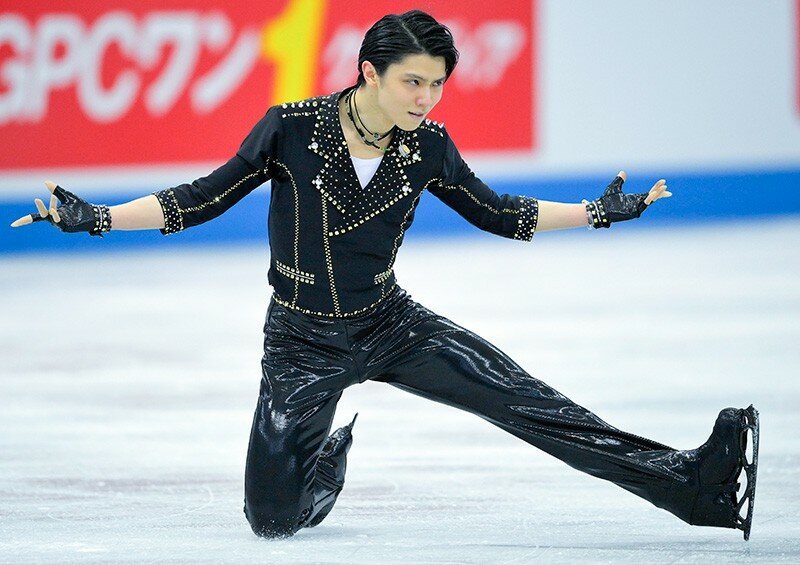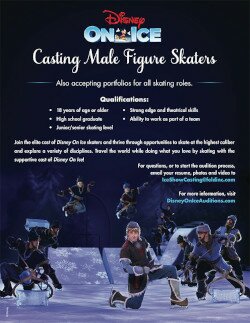
 Photo: Courtesy International Skating Union
Photo: Courtesy International Skating Union
By the time the 2020 All Japan Championships rolled around in December, it had been 10 months since Yuzuru Hanyu last took to the ice for a competition. He closed out the previous season with a resounding victory at 2020 Four Continents and, along with that, became the first man to complete the Grand Slam in figure skating.
The 26-year-old Japanese star has won everything there is to win — including back-to-back Olympic crowns. So what, you might ask, drives Hanyu to continue competing?
When the COVID-19 pandemic became a reality in North America in mid-March and the 2020 World Championships were cancelled, Yuzuru Hanyu returned to his Japanese homeland. As an asthmatic, he knew he would be at high risk if he caught the virus.
In the months following his departure from Canada, there had been no information or updates about what he was doing; whether he was training, or if he intended to continue competing. The first news came just a week before the national championships in late December, when the line-ups were announced and Hanyu’s name was on the men’s roster.
Though he chose not to compete at NHK Trophy in November because of his concerns about the coronavirus, when it came to the 2020 All Japan Championships he had no choice. If he wanted a place on the 2021 World team, he would have to compete to earn one. And so it was, with reluctance and mixed emotions, that Hanyu headed to Nagano in late December with the goal of capturing his fifth national title.
“To be honest, my way of thinking hasn’t changed. Personally, I always think about not getting infected in everything I do,” Hanyu said. “After the number of infected people rose sharply in the form of a third wave, I thought a lot about whether I should really perform. But since Four Continents was cancelled, I had to participate in the national championships to be able to qualify for Worlds.”
Hanyu said he had spent the previous 10 months at home with his family, and had avoided going out or meeting with anyone beyond his immediate household. “Usually I’m in Toronto and it’s not often that my whole family is able to get together and spend time.
“Because of the coronavirus, I was on my own for a long time. I want to put it into words, but it’s difficult to explain. At last year’s Grand Prix I was on my own and I realized for the first time how difficult that is. During this time, I felt alone and tired and I didn’t want to be alone anymore. Then, when I watched ‘Haru yo, Koi′ (an exhibition routine he debuted in the 2017-2018 season) and other past programs, I realized that I needed to go back to the rink.”
Training alone every day without a coach, Hanyu initially found it a challenge to stay in shape and went through a phase of feeling that everything he was doing was pointless. “The pressure of having to train alone; to work out the choreography on my own; wanting to meet the expectations of my audience … everyone seemed to have improved and only I was left in the same place alone,” he explained. “I saw how much better Shoma (Uno) and Yuma (Kagiyama) had gotten and I felt like an old man. I was really afraid of only getting worse. I put myself under pressure because I wanted to train the quad Axel, but it made my other jumps worse and I was in pain.
“Doubts gripped me, but then I started thinking back to past programs and all that I have accomplished so far. I think having a coach is an incredibly important thing, insofar as being able to provide new points of view and ones outside of your own. But on the flip side, as I have an abundant amount of experience it is easier for me to have a more objective point of view about things.”
Not having any distractions allowed the Japanese star to focus on “not just better training, but the best training so far,” and though he worked out a lot of things on his own, he continued to connect with those around him.
“Over a very long period of time — until the end of October or the beginning of November — I wasn’t able to do the triple Axel. I recorded my training, sent it to the coaches and got a lot of advice from afar. I am very grateful for that. That is how I was able to get through this difficult time.”
STYLISTIC CHANGES
His short program this season, set to the pop rock tune “Let Me Entertain You,” and his rhinestone-studded costume are a departure from the style Hanyu typically prefers. “I can’t say too much about the costume. The song is by Robbie Williams so it should be rocking in the first place and I wanted to match his image,” he explained. “Jeffrey Buttle chose the piece. Originally, I wanted to go with a piano melody, but we did not find what we were looking for. Jeffrey suggested two or three songs, but couldn’t really convince me. Seeing how difficult these times are, I wanted to have an uplifting piece. After all, everyone is watching despite the circumstances, which is why I wanted to bring a little light into their lives.
“I got the basics of the step sequences, but then changed the positions a little bit and thought up the arm movements myself. Regarding the jumps, I told Jeffrey where I would like to incorporate each one. I asked him a lot of questions, but he didn’t always answer, so I mostly decided by myself. I like the push and pull feel of the program. I put a lot of thought into it and tried a lot of things, as I really wanted to make each element special. That includes the jumps, where I breathe, and other technical aspects.
“I tried to take highlights of past programs, but in this program I put a lot of emphasis on matching the choreography to the song. Although I prepared the program mainly by myself, which was very exhausting, I think I was able to grow from it and I had a lot of people who supported me. Accordingly, I am very happy with the result and I am grateful to the coaches for believing in me.”
Hanyu turned to another Canadian to design his free skate. Shae-Lynn Bourne, who has choreographed a number of his programs over the years, crafted the routine to Isao Tomita’s “Heaven and Earth.”
“For me, the piece means a lot. It awakens a lot of feelings in me. This is a story that inspired me and it is a story that I want to pass on to my fans. I incorporated many elements that are important, but most of all the emphasis is on my jumps,” the two-time Olympic champion explained. “I want to show with my jumps what I feel at that moment and pass that on to the spectators. But for me, the most important thing is to leave it up to the spectators as to what they feel and see during my performance.”
Hanyu’s long program represents the Battle of Kawanakajima, which took place in 1561 between two feudal lords, Uesugi Kenshin and Takeda Shingen, who fought for control of a plain in the Shinaro province that is part of the present-day city of Nagano.
“The beginning of the piece was Shae’s idea. I imagine that I am fighting and my front arm is the armour of a samurai,” Hanyu explained about his opening pose. “I used the title of the taiga drama ‘Ten to Chi to’ (a long running Japanese television series). But for me, it is ‘Ten to chi no hito’ (a man between heaven and earth). My arm is the transition between where I am, and the sky above and the earth below. “Then the part with the Biwa (a Japanese short-necked lute) begins. This was part of the actual piece of music. It symbolizes that I actually don’t want to fight, but have to in order to protect my loved ones.
“The song is full of determination, like I am going to fight, or filled with a sense of preparing for battle. At the end, after the Ina Bauer, the Biwa sound while I am spinning is one I included from a different piece of music and layered it to make it original. I wanted to incorporate typical Japanese elements with traditional instruments and the Biwa was best suited for this.”
Hanyu also added a koto (a 13-stringed harp-like instrument) because he wanted to make the program even more ‘Japonesque.’ “I developed many different versions of the piece, but since I’m not a professional musician, I just adapted it to the step sequences and the choreography. The way Kenshin fought and his philosophy touched me deeply. My situation is similar and I could identify with him. Fighting and still not winning you can say is painful, so I am somewhat influenced by Kenshin’s overall sense of values about battles.
“I like everything about my program, but I am happiest about the fact that I mastered my jumps without having to use too much energy, and that I developed my own way of expressing myself. I want to adopt that for my short program as well — I want to reflect a rock feel, of course, but I want to convey that in a smarter way like Robbie Williams does. It is rock music, but it is more ‘English.’ I don’t know how to describe it. Anyway, I still want to work on it.”
REGAINING MOMENTUM
It had been five years since Hanyu collected the last of four consecutive national titles. He withdrew each of the three subsequent years due to injury or illness and finished second in 2019. “Last season I was not so good and my result was very frustrating. I wanted to do better this time,” he said. “Something happened after the Grand Prix and Japanese nationals last season. I had the feeling that I had not improved, that I had not fought enough. I felt like I wasn’t really growing, that I was slowly becoming unable to fight. I believed I had been too tired to fight.
“For a moment, I thought I had become tired of competing and I could probably give up at any point. I could always quit, but there are many people who support me who would certainly be very disappointed if I did that. I had a lot of doubts, but I realized that the best way to get rid of them was to compete, which is why I want to continue. It was important to me that I didn’t give up in times like these. It would have been disrespectful to my coach not to give my best and, unlike last year, I’m also now in good physical shape.”
Returning to Nagano was like coming full circle for Hanyu. It was there, in 2014, that he won his third national crown, and the following season claimed his first NHK Trophy title. “I have good memories of Nagano, so I was afraid of having a bad experience because of a misstep,” he said. “At that time, it was always very difficult for me and I couldn’t imagine that life experiences could positively influence figure skating. But now I understand that, and I am glad to have finally gained enough experience as a veteran to be able to bring it into my programs.
“There were problems in the short and, honestly speaking, neither performance I could call perfect,” Hanyu said with respect to his performances in Nagano. “But I feel very reassured about the long program, and I think those who watched feel reassured that I can do an original performance, and that the way I trained was right. I think I’ve found a training method that is suitable for my current body condition — one that helps me grow — so I’d like to keep refining it further. I hope that I can continue without injuries while challenging harder jumps.”
Hanyu intends to continue working on the quad Axel, and his goal remains to land it in competition. “In this current situation, it feels like my reason for training and the reason for wanting to keep skating could vanish, so that is why I am still pushing ahead against the impregnable wall. I want to look beyond that wall to where there are no other walls. I think that may be the only reason I am able to skate in this current situation.”
At this time, however, Hanyu is focused solely on his plan to include four quads in his long program, which he believes will give him a strong foundation to include a quad Axel at a later stage. “For now, making that go well should be the only thing I think about. Improving my body and my technical and physical fitness is definitely something I think I know best. In the last year I have gone through a lot of trial and error. I want to utilize that and put in the work in training to improve the technical aspects needed to rotate and land a quad Axel.”
FUTURE PLANS
Hanyu said he has not made a decision about whether he will return to his Toronto training base once the pandemic situation improves. He is also not thinking about the 2022 Olympic Winter Games at this point. “It is my personal opinion that as the current situation caused the postponement of the 2020 Tokyo Olympics and the violence of the coronavirus has not subsided, we are not in a position to be thinking about the Winter Olympics.
“I would like the Olympics to go ahead and of course I would like to win. It is the ultimate goal of competition for me. Therefore, I’ve personally stopped myself from thinking about the Olympics and shut down my thoughts about that right now.
“It’s been a very stressful year, and my sympathies are mostly with the doctors, people who have lost their jobs and are suffering financial difficulties because of the coronavirus. My problems are very minor in comparison. I realized how lucky I am to be able to figure skate and that figure skating is something special that brings me joy. I am very happy to have this privilege. For me, figure skating is the only way to express my feelings, and for this reason, I no longer want to compete for everyone else, but mainly for myself.”
In early September, Hanyu graduated from the School of Human Sciences at Japan’s Waseda University. His graduation ceremony, which was modified due to the pandemic, took place on Nov. 20. His dissertation was on the Application and Prospects for the Future of Motion Capture Technology in Figure Skating. “Doing research taught me how to examine something in a multi- faceted manner through analysis and verification,” he explained.
“I want to open doors, not just in competition, but also in the field of research. I hope that this will be useful in helping athletes improve their techniques and contribute to the development of figure skating. (Translation of quotes by Maria-Laura Brandmann)
Short Program: Let Me Entertain You
Long Program: Heaven and Earth
(This article was originally published in the IFS March/April 2021 issue)




